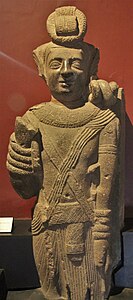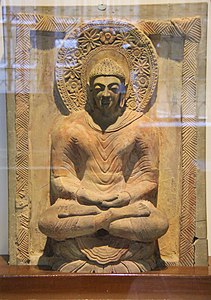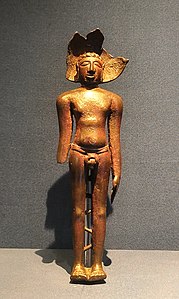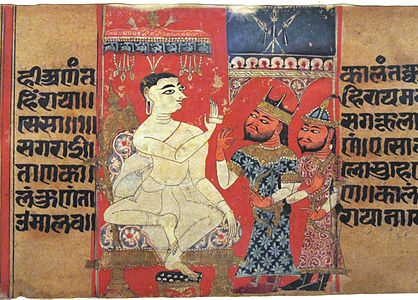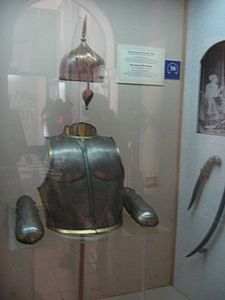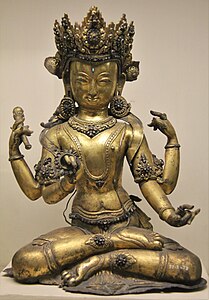
Chhatrapati Shivaji Terminus (officially Chhatrapati Shivaji Maharaj Terminus since 2017, formerly Victoria Terminus (VT), Bombay station code: CSMT (mainline)/ST (suburban)), is a historic railway terminus and UNESCO World Heritage Site in Mumbai, Maharashtra, India.

South Mumbai, colloquially SoBo from South Bombay in Indian English, administratively the Mumbai City District, is the city centre and the southernmost precinct of Greater Bombay. It extends from Colaba to Mahim and Sion neighbourhoods, and comprises the city's main business localities, making it the wealthiest urban precinct in India. Property prices in South Mumbai are by far the highest in India and among the highest in the world.

Kala Ghoda is a crescent-shaped art district/neighborhood in Mumbai, India. It hosts several of the city's heritage buildings including museums, art galleries and educational institutions like the Chhatrapati Shivaji Maharaj Vastu Sangrahalaya, the Jehangir Art Gallery, the National Gallery of Modern Art, and The Arts Trust - Institute of Contemporary Indian Art.
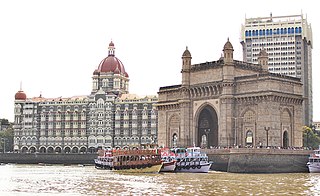
A resident of Mumbai is called a Mumbaikar. People prefer to stay close to a railway station for easy access to the metropolis. Many city-dwellers lead a fast-paced life with very little time for other activities owing to a significant amount of time spent on daily commuting.

Chiplun ( [t͡ʃipɭuːɳ]) is a city in Ratnagiri district in the state of Maharashtra, India. It is one of the financial and commercial Hubs of Ratnagiri district, and the headquarters of Chiplun taluka. It is about 250 km south of Mumbai and 90 km North of Ratnagiri in the Konkan region of Maharashtra, on the Mumbai–Goa highway (NH-66). It has a long history and a strong cultural background. Recent decades have seen much industrial development in it and its and surrounding areas.

Maharashtra attracts tourists from other Indian states and foreign countries. It was the second most visited Indian state by foreigners and fifth most visited state by domestic tourists in the country in 2021. Aurangabad is the tourism capital of Maharashtra.
Reena Saini Kallat is an Indian visual artist. She currently lives and works in Mumbai.
The architecture of Mumbai blends Gothic, Victorian, Art Deco, Indo-Saracenic & Contemporary architectural styles. Many buildings, structures and historical monuments remain from the colonial era. Mumbai, after Miami, has the second largest number of Art Deco buildings in the world.
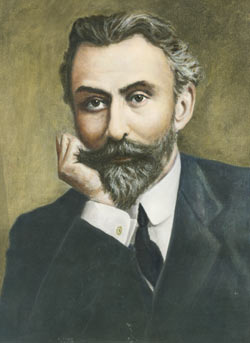
Sir Ratanji Jamsetji Tata was an Indian financier and philanthropist during the British Raj.
Rahul Mehrotra is Founder Principal of architecture firm RMA Architects of Mumbai + Boston, and is Professor of Urban Design and Planning and Chair of the Department of Urban Planning and Design at the Harvard Graduate School of Design (GSD) in Cambridge, Massachusetts.

Maharashtra state in India is known for its Famous caves and cliffs. It is said that the varieties found in Maharashtra are wider than the caves and rock-cut architecture found in the rock cut areas of Egypt, Assyria, Persia and Greece. The Buddhist monks first started these caves in the 2nd century BC, in search of serene and peaceful environment for meditation, and they found these caves on the hillsides.

The Victorian Gothic and Art Deco Ensembles of Bombay is a collection of 19th-century Victorian Revival public and 20th-century Mumbai Art Deco private buildings in the Fort precinct of Mumbai. This ensemble was declared a UNESCO World Heritage Site in 2018.

The Maratha Navy was the naval wing of the armed forces of the Maratha Empire, which existed from around the mid-17th century to the mid-18th century in the Indian subcontinent.

Chhatrapati Shivaji Maharaj Museum of Indian History (CSMMIH) is a private historical museum founded by François Gautier in 2012 under the banner of his not-for-profit organization, the Foundation For Advancement of Cultural Ties (FACT). The first phase the museum was inaugurated by Ravi Shankar and endorsed by Ajit Pawar and Nitin Gadkari. In addition to various exhibits the museum also has a freely accessible digital library on their website that has hundreds of books on Indian history and culture.
The Chhatrapati Shivaji Maharaj Smarak or Chhatrapati Shivaji Maharaj Memorial is a proposed monument Shivaji, the founder of the Maratha Empire. The statue will be located in Mumbai's Back Bay. As of May 2024, construction of the monument has not yet started despite being expected to be completed by October 2022.

The Mughal Sarai is a caravanserai located in Surat, Gujarat, India.

The Parel Relief or Parel Shiva is an important monolithic relief of the Hindu god Shiva in seven forms that is dated by the Archaeological Survey of India (ASI) to the late Gupta period, in the 5th or 6th century AD.
Abha Narain Lambah is an Indian conservation architect whose eponymous architectural practice has restored several of India's UNESCO World Heritage Sites like the Ajanta Caves, Golconda Fort and Mahabodhi Temple, and Mumbai's Victorian buildings like the Crawford Market, Royal Opera House, Asiatic Society of Mumbai Town Hall and Knesset Eliyahoo Synagogue.

The Jehangir Nicholson Art Foundation (JNAF) is a private, not-for-profit organization located in Mumbai, India, with its core interest in promoting the preservation, exhibition, education, and research of post-colonial Indian modern art. The collection is endowed by the personal collection of the late Jehangir Nicholson, comprising over 800 pieces of art across mediums from artists including M. F. Husain, Vasudeo S. Gaitonde, S. H. Raza, K. H. Ara, etc. The foundation is currently housed in the Chhatrapati Shivaji Maharaj Vastu Sangrahalaya, managing the Jehangir Nicholson Gallery - the modern and contemporary art wing of the museum.










